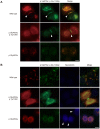Revertant mutation releases confined lethal mutation, opening Pandora's box: a novel genetic pathogenesis
- PMID: 24785414
- PMCID: PMC4006701
- DOI: 10.1371/journal.pgen.1004276
Revertant mutation releases confined lethal mutation, opening Pandora's box: a novel genetic pathogenesis
Abstract
When two mutations, one dominant pathogenic and the other "confining" nonsense, coexist in the same allele, theoretically, reversion of the latter may elicit a disease, like the opening of Pandora's box. However, cases of this hypothetical pathogenic mechanism have never been reported. We describe a lethal form of keratitis-ichthyosis-deafness (KID) syndrome caused by the reversion of the GJB2 nonsense mutation p.Tyr136X that would otherwise have confined the effect of another dominant lethal mutation, p.Gly45Glu, in the same allele. The patient's mother had the identical misssense mutation which was confined by the nonsense mutation. The biological relationship between the parents and the child was confirmed by genotyping of 15 short tandem repeat loci. Haplotype analysis using 40 SNPs spanning the >39 kbp region surrounding the GJB2 gene and an extended SNP microarray analysis spanning 83,483 SNPs throughout chromosome 13 in the family showed that an allelic recombination event involving the maternal allele carrying the mutations generated the pathogenic allele unique to the patient, although the possibility of coincidental accumulation of spontaneous point mutations cannot be completely excluded. Previous reports and our mutation screening support that p.Gly45Glu is in complete linkage disequilibrium with p.Tyr136X in the Japanese population. Estimated from statisitics in the literature, there may be approximately 11,000 p.Gly45Glu carriers in the Japanese population who have this second-site confining mutation, which acts as natural genetic protection from the lethal disease. The reversion-triggered onset of the disesase shown in this study is a previously unreported genetic pathogenesis based on Mendelian inheritance.
Conflict of interest statement
The authors have declared that no competing interests exist.
Figures




References
-
- Skinner BA, Greist MC, Norins AL (1981) The keratitis, ichthyosis, and deafness (KID) syndrome. Arch Dermatol 117: 285–289. - PubMed
-
- Janecke AR, Hennies HC, Gunther B, Gansl G, Smolle J, et al. (2005) GJB2 mutations in keratitis-ichthyosis-deafness syndrome including its fatal form. Am J Med Genet A 133A: 128–131. - PubMed
-
- Tsukada K, Nishio S, Usami S (2010) A large cohort study of GJB2 mutations in Japanese hearing loss patients. Clin Genet 78: 464–470. - PubMed
Publication types
MeSH terms
Substances
LinkOut - more resources
Full Text Sources
Other Literature Sources

